Causes of death - monthly statistics
Data extracted in May 2023
Planned article update: 21 June 2024
Highlights
In 2020, the highest number of deaths from COVID-19 in the EU (data available for 21 countries) was reported in November and the lowest in July.
In April, November and December of 2020, COVID-19 in the EU (data available for 21 countries) was the second most common cause of death, surpassing cancer.
Finland recorded the lowest peak monthly standardised death rate for COVID-19 in the EU (data available for 21 countries), with 3.3 deaths from COVID-19 per 100 000 inhabitants in April 2020, while Slovenia recorded the highest, with 77.3 in December 2020.
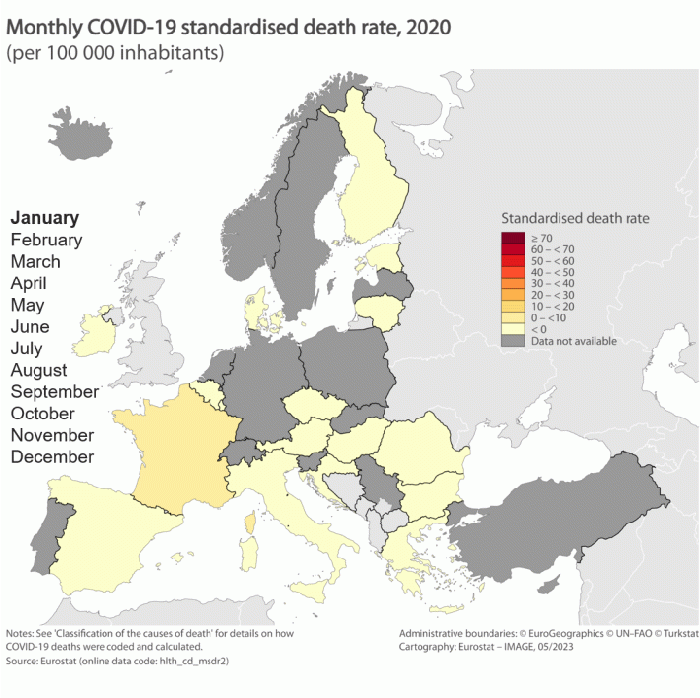
(per 100 000 inhabitants)
Source: Eurostat (hlth_cd_msdr2)
If gif feature does not display in preview, please double click to view in full-view
This article is the first to present data on monthly causes of death in the European Union (EU). Eurostat began collecting monthly data on causes of death in 2021, for reference year 2019, and these data are being presented here for the first time.
It is important to identify and record the underlying reasons for deaths and make the information available to policymakers, health services and the public. With this data, it is possible to describe and understand the rate and trends in mortality. The data also serve to give information on changing epidemiological circumstances. Most causes of death vary significantly by age and by sex, and some also vary by month or season. This article gives an overview of the monthly standardised death rates for EU Member States with analyses by country of residence and age of the deceased. The use of standardised death rates facilitates comparisons both over time and between countries, independent of different population age-structures. Please note that data are only available for 21 Member States, so there is no EU aggregate; data are also available for two EFTA countries: Iceland and Norway.
Full article
Monthly deaths in 2019 and 2020
There were 2.9 million deaths in total[1] in 2019, and over 3.2 million in 2020, across the 21 Member States for which monthly mortality data are available.
In 2019, the highest number of total deaths reported in the 21 Member States was in January with 297 066; the number of deaths gradually decreased over the next few months, with a small increase between June and July of 3 914 deaths. The lowest number of total deaths was reported in September with 215 114 deaths. The number of deaths then began to increase to 256 027 deaths in December 2019.
In 2020, there were fewer total deaths reported in the 21 Member States in January and February when compared with 2019. In March 2020, the number of total deaths increased by 70 521 to 321 590 deaths across the 21 Member States for which data are available. The highest number of deaths, 342 574, was reported in November and the lowest number was reported in June, 222 208 deaths.
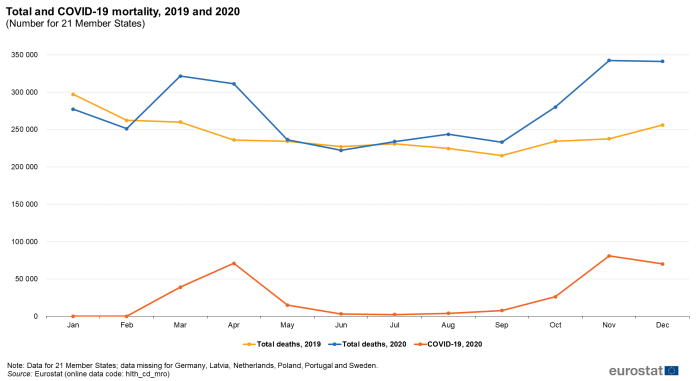
(Number for 21 Member States)
Source: Eurostat (hlth_cd_mro)
The first deaths reported as caused by COVID-19 within the EU were in France in January 2020 (11 deaths). By the end of March 2020, there had been at least one COVID-19 death reported in all but one (Malta) of the EU Member States for which data are available. The highest number of deaths from COVID-19 were reported in November, with 80 970 deaths from COVID-19 reported across the 21 Member States. The lowest number of deaths reported, not including January and February, was recorded in July with 2 277 deaths from COVID-19.
Leading causes of death 2019 and 2020
Diseases of the circulatory system was the leading cause of death in 2019 and in 2020, for all of the 21 Member States for which data are available. As can be seen in Figure 2, this varied across months; the highest number of deaths from diseases of the circulatory system in 2019 was reported in January (109 956 deaths), and the lowest in September (72 266 deaths). In 2020, the highest number of deaths from diseases of the circulatory system was reported in December (106 757 deaths), and the lowest in June (76 812 deaths).
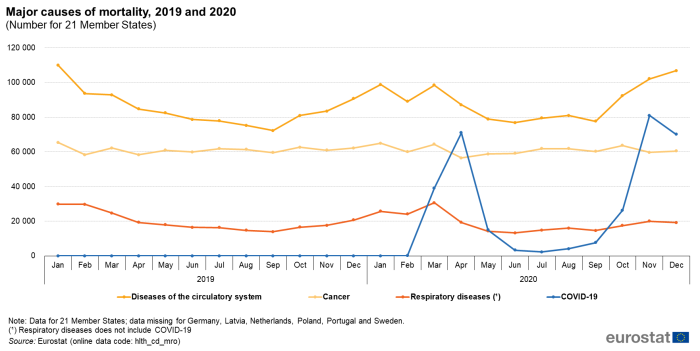
(Number for 21 Member States)
Source: Eurostat (hlth_cd_mro)
The number of deaths from cancer remained relatively stable across 2019 and 2020 in the 21 Member States for which data are available; the highest number of deaths from cancer over the 2-year period was in January 2019 with 65 411 deaths and the lowest was in April 2020 with 56 492 deaths (Figure 2).
Respiratory diseases represented the third leading cause of death in 2019, and fourth leading cause of death in 2020. In 2019, deaths from respiratory diseases ranged from just under 14 000 to over 29 000. In 2020, the number of deaths from respiratory diseases ranged from 13 200 to 25 700.
In 2020, COVID-19 became one of the leading causes of death in the EU, (see Statistics Explained article Causes of death statistics for more information). In terms of monthly deaths, the number of deaths across the 21 Member States for which data are available varied greatly over the course of 2020. There were two peaks, with a higher number of deaths; in April, with 71 020 deaths from COVID-19 and in November, with 80 970 deaths. In April, November and December of 2020, the number of deaths from COVID-19 surpassed the number of deaths from cancer in the 21 Member States for which data are available.
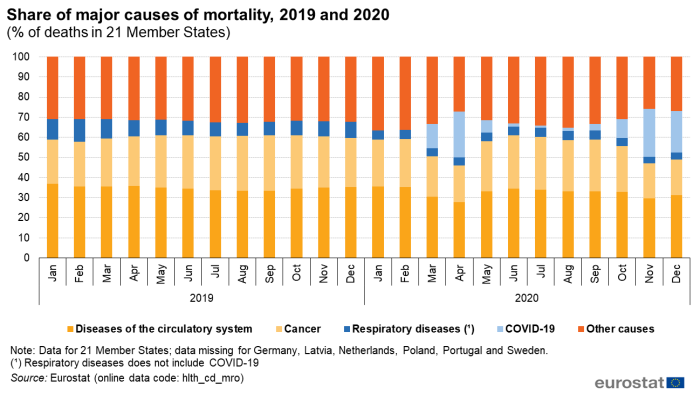
(% of deaths in 21 Member States)
Source: Eurostat (hlth_cd_mro)
In terms of share of deaths in the 21 Member States for which data are available, the share of deaths from diseases of the circulatory system ranged from 33.5 % to 37.0 % in 2019, and from 28.0 % to 35.6 % in 2020. The share of deaths from cancer, ranged from 22.0 % to 27.7 % in 2019, and from 17.4 % to 26.6 % in 2020.
In 2020, the highest share of deaths from COVID-19 among the 21 Member States for which data are available was recorded in November at 23.6 %, and the smallest share was reported in July, at 1 % (not including January and February).
Comparing influenza, pneumonia and COVID-19
Figure 4 shows the share of deaths from influenza, pneumonia and COVID-19 out of the deaths from respiratory diseases and COVID-19. In 2019, the highest share of deaths from influenza was in February, when 11 % of deaths from respiratory diseases were due to influenza. The lowest share of deaths was in August at less than 0.1 %. In 2020, the highest share of deaths from influenza was in February, when 5.4 % of deaths from respiratory diseases and COVID-19 were due to influenza. After February 2020, this share remained less than 1.6 % for the rest of the year.
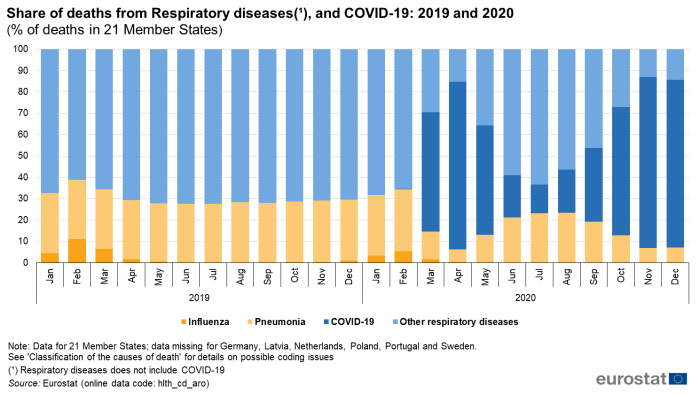
(% of deaths in 21 Member States)
Source: Eurostat (hlth_cd_mro)
The share of respiratory deaths from pneumonia in 2019 ranged from 27.2 % in May, to 28.8 % in November. In 2020, the share of deaths from pneumonia was highest in February, where it accounted for 29.0 % of all deaths from either respiratory diseases or COVID-19; the share of deaths from pneumonia was lowest in April, at 5.9 %.
In 2020, the share of deaths from COVID-19 was highest in November, at 80.2 %, and lowest in January and February, at less than 0.2 %. The share of COVID-19 deaths was also below 20 % in June and July.
Standardised death rate for COVID-19
The standardised death rate for COVID-19 varied greatly between countries, and across months. In the majority of countries for which data are available, the highest peak in deaths from COVID-19 was reported in either November or December 2020. Five countries (Belgium, Ireland, Spain, France, and Finland) reported the peak standardised death rate from COVID-19 in April 2020.
The highest monthly standardised death rate was reported by Slovenia in December 2020 with 77.3 deaths from COVID-19 per 100 000 inhabitants. On the other hand, the highest peak in Finland reached only 3.3 deaths from COVID-19 per 100 000 inhabitants, in April 2020.
The lowest monthly standardised death rate of 0 deaths from COVID-19 per 100 000 inhabitants was reported by several countries in January and February, as some countries had not yet reported any COVID-19 deaths. Thereafter, the only months in which some countries did not report any COVID-19 were June, when Malta and Slovakia did not report any deaths from this cause, and July when this was the case in Estonia, Cyprus and Malta.
The monthly standardised death rate for COVID-19 was higher among people aged 65 and over for all months, in all reporting countries, compared to the standardised death rate for COVID-19 among people aged under 65 years. The highest rate among people over 65 was reported by Slovenia in December 2020, with 378.3 deaths from COVID-19 per 100 000 people aged over 65 (Figure 5 and 6; for other countries please see the excel file attached).
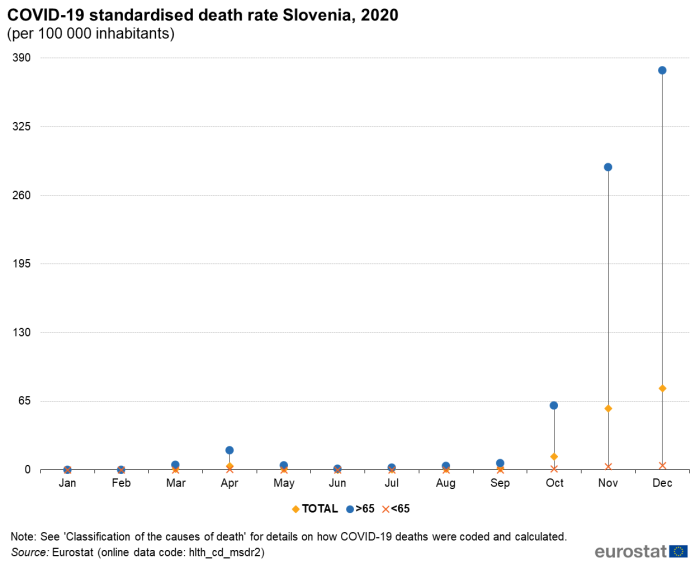
(per 100 000 inhabitants)
Source: Eurostat (hlth_cd_mro)
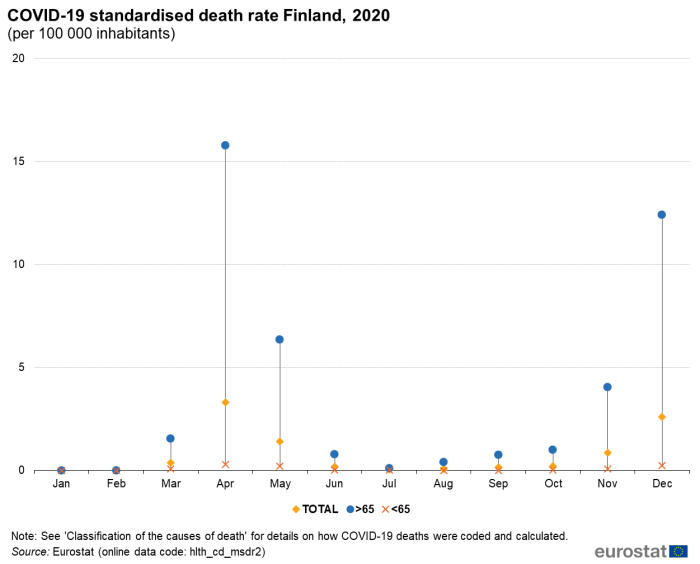
(per 100 000 inhabitants)
Source: Eurostat (hlth_cd_mro)
The lowest peak standardised death rate for COVID-19 among people over 65 was reported by Finland, in April 2020, with 15.8 deaths from COVID-19 per 100 000 people aged over 65. Denmark, Estonia, Cyprus, Malta, and Greece also reported a peak standardised death rate less than 81 deaths from COVID-19 per 100 000 people aged over 65. In all other countries the peak standardised death rate from COVID-19 in this age group was between 113 and 279 deaths from COVID-19 per 100 000 people aged over 65.
The highest monthly standardised death rate from COVID-19 among people under 65 was reported by Bulgaria in November 2020, with 17 deaths from COVID-19 per 100 000 people aged under 65. The lowest peak standardised death rate for COVID-19 among this age group was reported by Finland in April 2020, with 0.28 deaths from COVID-19 per 100 000 people aged under 65.
Source data for tables and graphs
Data sources
Statistics on the underlying causes of death provide information on mortality patterns. This source is documented in more detail in this background article, which provides information on the scope of the data, its legal basis, the methodology employed, as well as related concepts and definitions.
Legal basis for the data collection
Since reference year 2011, reporting countries submit data to Eurostat based on the requirements of Regulation (EC) No 1338/2008 on Community statistics on public health and health and safety at work, and Regulation (EU) No 328/2011 on Community statistics on public health and health and safety at work, as regards statistics on causes of death.
There are currently 33 countries submitting the CoD data to Eurostat:
- All 27 EU Member States
- EFTA countries (Iceland, Liechtenstein, Norway and Switzerland)
- Candidate countries and potential candidates (Serbia and Türkiye)
As of 2021, Eurostat invited countries to provide month of death for reference years 2019 and 2020, following consultations on potential Public Health data collections on the COVID-19 pandemic. Data on month of death was provided by 21 EU Member States; Germany, Latvia, the Netherlands, Poland, Portugal and Sweden have not been able to provide data on month of death.
Classification of the causes of death
Statistics on the causes of death are based on the medical information provided in the death certificate. Causes of death are classified by the 86 causes in the European shortlist which is based on the International Classification of Diseases and Related Health Problems (ICD). When the outbreak of COVID-19 started, the WHO introduced emergency codes in the ICD version 10 (ICD-10) that countries could use to report deaths from COVID-19.
In Eurostat's dissemination database, the codes are available as follows:
- U071; COVID-19, virus identified (deaths where COVID-19 has been confirmed by laboratory testing)
- U072; COVID-19, virus not identified (COVID-19, virus not identified)
- U_COV19_OTH; COVID-19 other (COVID-19 death not elsewhere defined)
The data for COVID-19 reported in this article was calculated by adding these three codes, however the data disseminated in Eurostat's dissemination database are separated by code. For more information about ICD-10 codes, click here.
Dying with COVID or dying from COVID-19
The Eurostat causes of death data collection is based on confirmed death certificates established by medical experts assessing the underlying cause of death. There is difference in the coding of cases of COVID-19 deaths, where COVID-19 was the established underlying cause of death (deaths from COVID-19), and where deaths occurred in someone who had a positive COVID-19 test at or close to the time of death (deaths with COVID-19). Here, death certificates may establish another cause of death despite the deceased dying with COVID-19. Nevertheless, there may be differences in how countries determined the underlying cause of death, particularly in cases where the deceased had multiple morbidities, or coinfections with other respiratory diseases (e.g. pneumonia).
Standardised death rate
The number of deaths from a particular cause of death can be expressed relative to the size of the population. A standardised death rate is adjusted to a standard age distribution. This facilitates comparisons of rates over time and between countries. The European standard population used for the standardisation of crude rates is based on the European Standard Population (ESP) in use since the summer of 2013.
Context
Statistics on causes of death are among the oldest medical statistics available. They provide information on developments over time and differences in causes of death between countries. These statistics play a key role in the general information system relating to the state of health in the EU. They may be used to determine which preventive and medical-curative measures or which investment in research might increase the life expectancy of the population.
Therefore, data on causes of death are often used as a tool for evaluating health systems in the EU and policy makers may use them for evidence-based health policy. The EU promotes a comprehensive approach to tackling major and chronic diseases, through integrated action on risk factors across sectors and combined with efforts to strengthen health systems towards improved prevention and control.
COVID-19 pandemic
The COVID-19 pandemic highlighted the need to prioritise public health, and strengthen healthcare systems across the EU and globally. In response to the pandemic, the European Commission took a series of actions to contain the spread of the coronavirus, support national health systems and counter the socio-economic impact of the pandemic, at both national and EU level.
This included:
- Supporting research and development in vaccines, and implementing a vaccine strategy.
- Launching the European Health Emergency preparedness and Response Authority (HERA), which aims to prevent, detect, and rapidly respond to health emergencies.
- Participating in COVAX, the world's facility for fair and universal access to COVID-19 vaccines.
- Laying the foundation for establishing a European Health Union, based on two pillars:
- A stronger health security framework, and
- More robust EU agencies.
You can read more about the Commission’s response to the COVID-19 pandemic here.
Direct access to
Online publications
Causes of death
- Causes_of_death_statistics
- Causes of death statistics by age group
- Preventable and treatable mortality statistics
Health status
Specific health conditions
- Cardiovascular diseases statistics
- Cancer statistics
- Cancer statistics — specific cancers
- Respiratory diseases statistics
- Mental health and related issues statistics
- Accidents and injuries statistics
Methodology
General health statistics articles
- Health (t_hlth)
- Causes of death (t_hlth_cdeath)
- Health (hlth)
- Causes of death (hlth_cdeath)
- Causes of death (ESMS metadata file — hlth_cdeath_sims)
- Revision of the European Standard Population — Report of Eurostat's task force — 2013 edition
- European Commission — Directorate-General for Health and Food Safety — Non-communicable diseases
- European Commission — Directorate-General for Health and Food Safety — European Core Health Indicators (ECHI), Health Status indicators, Disease-specific mortality
- Joint OECD / European Commission report Health at a Glance: Europe
- WHO Global Health Observatory (GHO) — Mortality and global health estimates
Notes
- ↑ European statistics in the domain of ‘causes of death’ cover all registered deaths and stillbirths occurring in each Member State, based on death certificates. Not all deaths are accompanied by a death certificate, therefore there may be differences to the total number of deaths reported under other data collections. In this article, ‘total deaths’ refers to all registered deaths from age 0 days (the variable ‘All causes of death (A00-Y89) excluding S00-T98’ in Eurostat’s dissemination database).